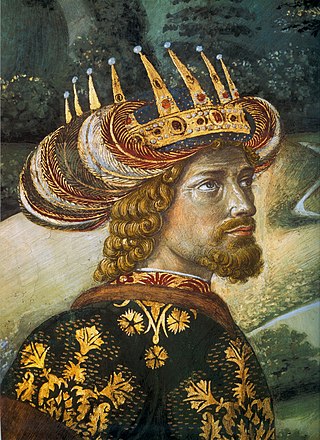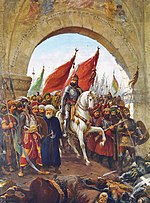
The 15th century was the century which spans the Julian dates from 1 January 1401 to 31 December 1500 (MD).
The 1460s decade ran from January 1, 1460, to December 31, 1469.
The 1450s decade ran from January 1, 1450, to December 31, 1459.
Year 1452 (MCDLII) was a leap year starting on Saturday of the Julian calendar.

Manuel II Palaiologos or Palaeologus was Byzantine emperor from 1391 to 1425. Shortly before his death he was tonsured a monk and received the name Matthew. His wife Helena Dragaš saw to it that their sons, John VIII and Constantine XI, became emperors. He is commemorated by the Greek Orthodox Church on July 21.

Constantine XI Dragases Palaiologos or DragašPalaeologus was the last Roman (Byzantine) emperor, reigning from 1449 until his death in battle at the Fall of Constantinople in 1453. Constantine's death marked the definitive end of the Eastern Roman Empire, which traced its origin to Constantine the Great's foundation of Constantinople as the Roman Empire's new capital in 330.

John VIII Palaiologos or Palaeologus was the penultimate Byzantine emperor. Ruling from 1425 to 1448, he attempted, and failed, to bring about the reunification of the Orthodox and Catholic churches and prioritized the protection of Constantinople against the Ottoman Empire. He was succeeded by his brother, Constantine XI.

The fall of Constantinople, also known as the conquest of Constantinople, was the capture of the capital of the Byzantine Empire by the Ottoman Empire. The city was captured on 29 May 1453 as part of the culmination of a 53-day siege which had begun on 6 April.
This is an alphabetical index of people, places, things, and concepts related to or originating from the Byzantine Empire. Feel free to add more, and create missing pages. You can track changes to the articles included in this list from here.

The House of Palaiologos, also found in English-language literature as Palaeologus or Palaeologue, was a Byzantine Greek noble family that rose to power and produced the last and longest-ruling dynasty in the history of the Byzantine Empire. Their rule as Emperors and Autocrats of the Romans lasted almost two hundred years, from 1259 to the Fall of Constantinople in 1453.
George Sphrantzes, also Phrantzes or Phrantza, was a late Byzantine Greek historian and Imperial courtier. He was an attendant to Emperor Manuel II Palaiologos, protovestiarites under John VIII Palaiologos, and a close confidant to Constantine XI Palaiologos, the last Byzantine emperor. He was an eyewitness of the Fall of Constantinople in 1453, made a slave by the victorious Ottomans, but ransomed shortly afterwards. Sphrantzes served the surviving members of the Palaiologian family for the next several years until taking monastic vows in 1472. It was while a monk he wrote his history, which ends with the notice of Sultan Mehmed II's attempt to capture Naupaktos, which he dates to the summer of 1477; Sphrantzes is assumed to have died not long after that event.
Loukas Notaras was a Byzantine Greek statesman who served as the last megas doux or grand Duke and the last mesazon of the Byzantine Empire, under emperors John VIII Palaiologos and Constantine XI Palaiologos.
Manuel Palaiologos was the youngest son of Thomas Palaiologos, a brother of Constantine XI Palaiologos, the final Byzantine emperor. Thomas took Manuel and the rest of his family to Corfu after the Fall of Constantinople in 1453 and the subsequent Ottoman invasion of the Morea in 1460. After Thomas's death in 1465, the children moved to Rome, where they were initially taken care of by Cardinal Bessarion and were provided with money and housing by the papacy.

The Byzantine–Ottoman wars were a series of decisive conflicts between the Byzantine Greeks and Ottoman Turks and their allies that led to the final destruction of the Byzantine Empire and the rise of the Ottoman Empire. The Byzantines, already having been in a weak state even before the partitioning of their Empire following the 4th Crusade, failed to recover fully under the rule of the Palaiologos dynasty. Thus, the Byzantines faced increasingly disastrous defeats at the hands of the Ottomans. Ultimately, they lost Constantinople in 1453, formally ending the conflicts.

The Byzantine Empire was ruled by the Palaiologos dynasty in the period between 1261 and 1453, from the restoration of Byzantine rule to Constantinople by the usurper Michael VIII Palaiologos following its recapture from the Latin Empire, founded after the Fourth Crusade (1204), up to the Fall of Constantinople to the Ottoman Empire. Together with the preceding Nicaean Empire and the contemporary Frankokratia, this period is known as the late Byzantine Empire.

The Palaiologan army refers to the military forces of the Byzantine Empire under the rule of the Palaiologos dynasty, from the late 13th century to its final collapse in the mid-15th century. The army was a direct continuation of the forces of the Empire of Nicaea, which itself was a fractured component of the formidable Komnenian army of the 12th century. Under the first Palaiologan emperor, Michael VIII, the army's role took an increasingly offensive role whilst the naval forces of the empire, weakened since the days of Andronikos I Komnenos, were boosted to include thousands of skilled sailors and some 80 ships. Due to the lack of land to support the army, the empire required the use of large numbers of mercenaries.

The Morea revolt of 1453–1454 was a failed peasant rebellion carried out against the rule of the brothers Thomas and Demetrios Palaiologos, rulers of the Byzantine Despotate of the Morea in the Peloponnese peninsula.
Since its fall, the issue of succession to the Byzantine Empire has been a major point of contention both geopolitically, with different states laying claim to its legacy and inheritance, and among the surviving members of the Byzantine nobility and their descendants. Historically, the most prominent claims have been those of the Ottoman Empire, which conquered Byzantium in 1453 and ruled from its former capital, Constantinople; the Russian Empire, as the most powerful state practising Eastern Orthodox Christianity; and various nobles and figures in Western Europe of increasingly spurious and questionable imperial descent.

After the conquest of Constantinople in 1453, the sultans of the Ottoman Empire laid claim to be the legitimate Roman emperors, in succession to the Byzantine emperors who had previously ruled from Constantinople. Based on the concept of right of conquest, the sultans at times assumed the styles kayser-i Rûm and basileus. The assumption of the heritage of the Roman Empire also led the Ottoman sultans to claim to be universal monarchs, the rightful rulers of the entire world.












